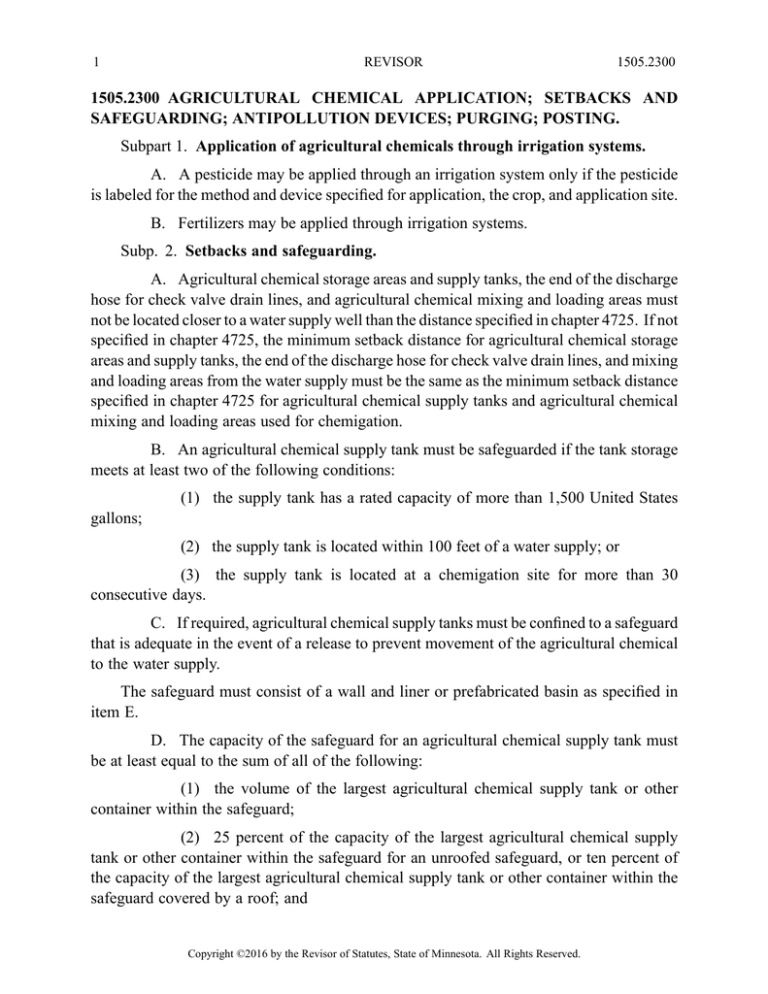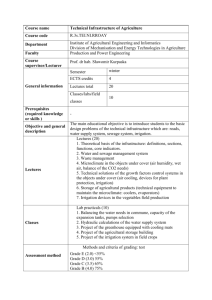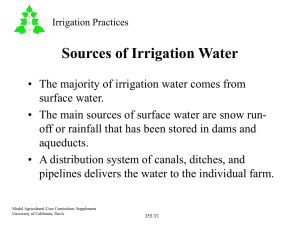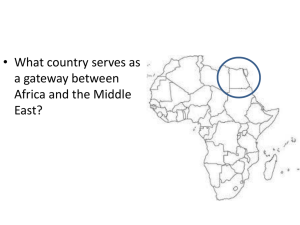
1
REVISOR
1505.2300
1505.2300 AGRICULTURAL CHEMICAL APPLICATION; SETBACKS AND
SAFEGUARDING; ANTIPOLLUTION DEVICES; PURGING; POSTING.
Subpart 1. Application of agricultural chemicals through irrigation systems.
A. A pesticide may be applied through an irrigation system only if the pesticide
is labeled for the method and device specified for application, the crop, and application site.
B. Fertilizers may be applied through irrigation systems.
Subp. 2. Setbacks and safeguarding.
A. Agricultural chemical storage areas and supply tanks, the end of the discharge
hose for check valve drain lines, and agricultural chemical mixing and loading areas must
not be located closer to a water supply well than the distance specified in chapter 4725. If not
specified in chapter 4725, the minimum setback distance for agricultural chemical storage
areas and supply tanks, the end of the discharge hose for check valve drain lines, and mixing
and loading areas from the water supply must be the same as the minimum setback distance
specified in chapter 4725 for agricultural chemical supply tanks and agricultural chemical
mixing and loading areas used for chemigation.
B. An agricultural chemical supply tank must be safeguarded if the tank storage
meets at least two of the following conditions:
(1) the supply tank has a rated capacity of more than 1,500 United States
gallons;
(2) the supply tank is located within 100 feet of a water supply; or
(3) the supply tank is located at a chemigation site for more than 30
consecutive days.
C. If required, agricultural chemical supply tanks must be confined to a safeguard
that is adequate in the event of a release to prevent movement of the agricultural chemical
to the water supply.
The safeguard must consist of a wall and liner or prefabricated basin as specified in
item E.
D. The capacity of the safeguard for an agricultural chemical supply tank must
be at least equal to the sum of all of the following:
(1) the volume of the largest agricultural chemical supply tank or other
container within the safeguard;
(2) 25 percent of the capacity of the largest agricultural chemical supply
tank or other container within the safeguard for an unroofed safeguard, or ten percent of
the capacity of the largest agricultural chemical supply tank or other container within the
safeguard covered by a roof; and
Copyright ©2016 by the Revisor of Statutes, State of Minnesota. All Rights Reserved.
2
REVISOR
1505.2300
(3) the total volume of released liquid that would be displaced by the portions
of all other containers with the safeguard to the height of the safeguard wall and all other
fixtures and materials located within the safeguard.
E. The walls and base of a safeguard may be made of ferrous metal, reinforced
concrete, solid reinforced masonry, synthetic lined earth, or prefabricated ferrous metal or
synthetic materials. The safeguard must be designed according to standard engineering
practices to be leakproof and to withstand a full hydrostatic head of released liquid to the
height of the safeguard.
(1) Masonry walls must be reinforced, capped with concrete, and parged on
the interior. The joint between any masonry wall and any floor or liner must use internal
waterstops or similar materials to make the joint leakproof. Control joints protected with
waterstops or similar materials must be used for the base. The interior base and walls must
be coated with a material resistant to agricultural chemicals. Cracks and seams must be
sealed.
(2) The joints between a reinforced concrete wall and any floor or liner must
use internal waterstops or similar materials to make the joint leakproof. Control joints
protected with waterstops or similar materials must be used for the base. The interior base
and walls must be coated with a material resistant to agricultural chemicals. Cracks and
seams must be sealed.
(3) Synthetic liners must have a minimum thickness of 30 mils (0.8
millimeters), be chemically compatible with the materials being stored within the
safeguard, photo resistant, and puncture resistant. The earthen base of a synthetic liner
must be free of large rocks, angular stones, sticks, or other materials that may puncture the
liner.
(4) A prefabricated safeguard must be composed of rigid walls and a base
of ferrous metal or synthetic materials that are resistant to corrosion, puncture, or cracking.
Materials used for the safeguard must be chemically compatible with the materials being
stored within the safeguard. Synthetic materials must be photo- and puncture-resistant.
(5) The base and walls of a safeguard may not contain a drain or similar
opening.
Subp. 3. Antipollution devices. Chemigation systems must be filled with
antipollution devices as detailed in this subpart. The devices must be designed and built
of materials suitable for those purposes, including agricultural chemical compatibility,
and must be kept functional during chemigation. Antipollution devices may be installed
Copyright ©2016 by the Revisor of Statutes, State of Minnesota. All Rights Reserved.
3
REVISOR
1505.2300
as portable devices for use on other permitted chemigation systems, except that portable
devices are not allowed for use on systems connected to the public water supply.
A. A mainline irrigation system supply reduced pressure zone backflow preventer
or two check valves in a series must be provided for systems directly connected to a water
supply, and must be located in the irrigation system supply pipeline between the irrigation
system water supply pump or source of irrigation water and the point of injection of the
agricultural chemical.
The following additional conditions apply:
(1) Mainline check valves:
(a) a single mainline check valve may be used for the application of
fertilizer;
(b) mainline check valve backflow prevention devices must meet the
design and equipment standards in item B;
(c) mainline check valve backflow prevention devices must be tested
and certified by an independent testing laboratory to meet the performance standards in
item B; and
(d) mainline check valves must be stamped, tagged, or otherwise
marked to indicate working pressure, flow rate, and direction, and date, month, and year
of manufacture.
(2) Reduced pressure zone backflow preventers:
(a) a reduced pressure zone backflow preventer must be used when the
source of irrigation water is potable water; and
(b) a reduced pressure zone backflow preventer must be approved by
the Department of Health under chapter 4714, and applicants must install and maintain a
reduced pressure zone backflow preventer under chapter 4714.
The commissioner shall keep and provide to interested persons a list of Department of
Health approved reduced pressure zone backflow preventers and mainline check valves
certified by independent testing laboratories. Mainline check valves approved by the
commissioner under repealed parts 1505.2000 to 1505.2080 may continue to be used after
October 12, 1992, if the mainline check valves comply with item B and the department has
been notified of any changes in design or materials.
B. If a single irrigation system supply check valve or two irrigation system supply
check valves in a series are used, each check valve must be equipped with an inspection port
or similar device and be immediately preceded in the irrigation system by a vacuum relief
valve and automatic low pressure drain valve.
Copyright ©2016 by the Revisor of Statutes, State of Minnesota. All Rights Reserved.
4
REVISOR
1505.2300
The inspection port must be installed on the horizontal irrigation pipeline on the supply
side of each check valve in a manner that the inlet to the automatic low pressure drain can
be easily observed during irrigation system shutdown.
The vacuum relief valve must be installed on the top of the horizontal irrigation pipeline
on the supply side of the check valve. The valve must have an orifice size of at least
a three-quarter inch diameter for a four-inch pipe; a one inch diameter for a five-inch to
eight-inch pipe; and a two inch diameter for a ten-inch or 12-inch pipe.
The automatic low pressure drain must be provided on the bottom of the horizontal
irrigation pipeline on the supply side of the check valve. The device must have an internal
and external orifice size of at least a three-quarter inch diameter. If two check valves in a
series are required to be used, the check valve located in line nearest to the pivot or irrigation
system must meet one of the following specifications:
(1) the check valve must use a spring-loaded, automatic, low pressure drain
or an automatic low pressure drain with similar operating characteristics; or
(2) the check valve must use an automatic low pressure drain that will drain
the supply side of the body of the check valve within three minutes of system shutdown.
The drain may not extend beyond the inside surface of the bottom of the irrigation
pipeline or conduit and must be at least two inches above grade. The device must be
positioned, or the location of the grade adjusted, so that liquid will discharge away from
a water supply when draining occurs.
An irrigation system supply check valve must be of heavy duty construction with all
materials, including internal parts, resistant to corrosion or protected to resist corrosion. It
must be rated a minimum of 150 pounds per square inch working pressure and be quick
closing by spring action and tight sealing so that no leakage occurs at joints or the valve
seat when subjected to an internal hydrostatic pressure test of at least 300 pounds per square
inch for one minute. There must be no leakage at joints or the valve seat when the check
valve is subjected to an internal hydrostatic pressure equivalent to the head of a column of
water five feet high, retained within the downstream portion of the valve body for 16 hours.
Irrigation system supply check valves, when installed, must be level except that a
deviation of not more than ten degrees from the horizontal is permitted.
C. An injection line check valve that is resistant to agricultural chemicals must
be provided on the agricultural chemical injection line between the point of agricultural
chemical injection into the irrigation system and the agricultural chemical injection unit,
pump, or solution tank, and be functional to prevent the flow of liquid from the irrigation
line to the agricultural chemical injection device and the flow of liquid or material from the
agricultural chemical supply tank to the irrigation line.
Copyright ©2016 by the Revisor of Statutes, State of Minnesota. All Rights Reserved.
5
REVISOR
1505.2300
D. An interlock, such as electrical, pressure, mechanical, or water motor, must
be provided between the irrigation system or water pump and the agricultural chemical
injection unit. If interruption of the irrigation water flow occurs, the interlock must, at a
minimum, cause the shutdown of the agricultural chemical injection unit.
E. A low pressure shutdown device must be used with the irrigation system that
will shut down the irrigation system if the water pressure decreases to the point when an
incident may occur.
Subp. 4. Purging system. The irrigation system must be operated as necessary on
each and every occasion after an agricultural chemical injection is terminated to allow for
a complete purging of the agricultural chemical from the system.
Subp. 5. Posting of sites. Sites being treated with pesticides through chemigation
systems must be posted with signs during pesticide treatment. The posting of signs is
governed by items A to D.
A. Signs must be in compliance with subitems (1) to (3).
(1) Signs must be at least eight and one-half inches by 11 inches, highly
visible, with contrasting colors for letters and background.
(2) Letters must be at least three-eighths of an inch tall.
(3) Signs must contain at least:
(a) the signal word from the pesticide label;
(b) the name of the pesticide;
(c) the date of treatment; and
(d) the reentry date as described on the pesticide label.
B. Signs must be conspicuously placed at usual points of entry for all sites
and at property corners for nongreenhouse sites that are immediately adjacent to public
transportation routes or other public or private nonagricultural property, except that signs
must be placed no greater than 100 feet apart for a field chemigation site that is located
immediately adjacent to a public area such as a park, school, or residential area.
C. Signs must be removed after the reentry date expires unless signs are of a more
permanent nature, such as laminated signs, in which case information must be updated as
necessary.
D. If more restrictive instructions for posting exist on the label of the pesticide
being used in chemigation, the label instructions must be totally followed.
Statutory Authority: MS s 18C.575
History: 17 SR 711; 40 SR 71
Copyright ©2016 by the Revisor of Statutes, State of Minnesota. All Rights Reserved.
6
REVISOR
Published Electronically: April 1, 2016
Copyright ©2016 by the Revisor of Statutes, State of Minnesota. All Rights Reserved.
1505.2300



